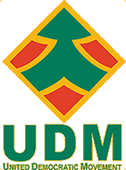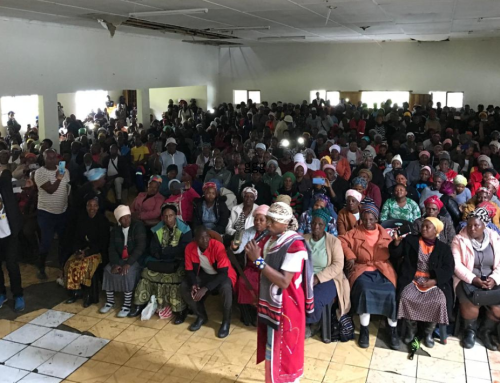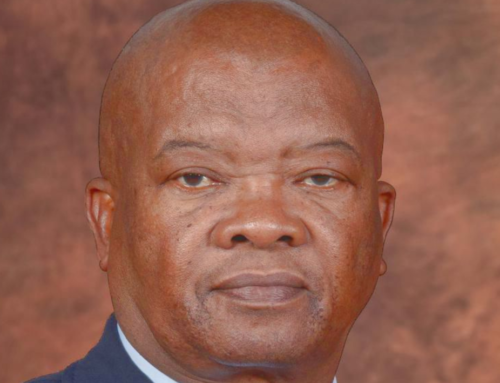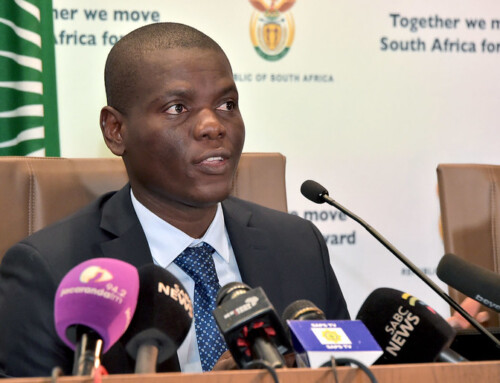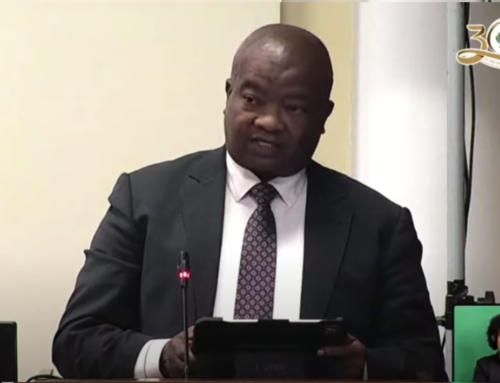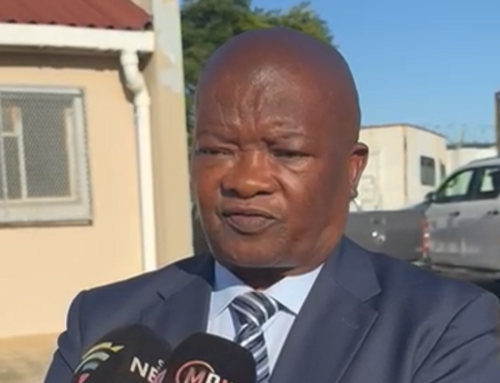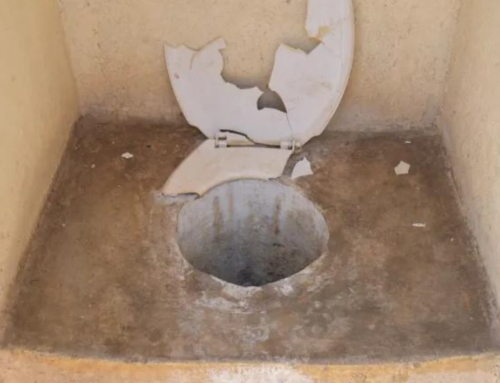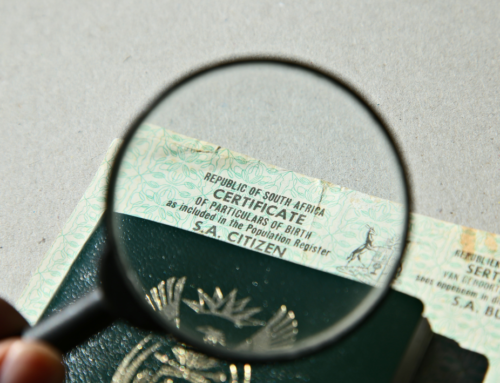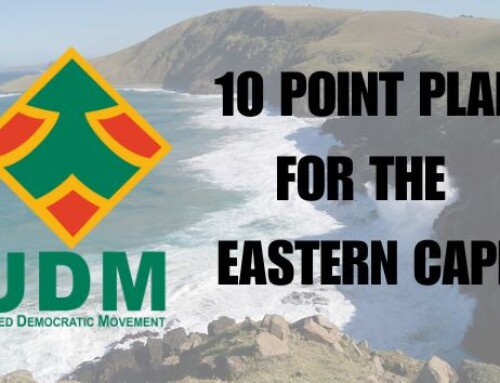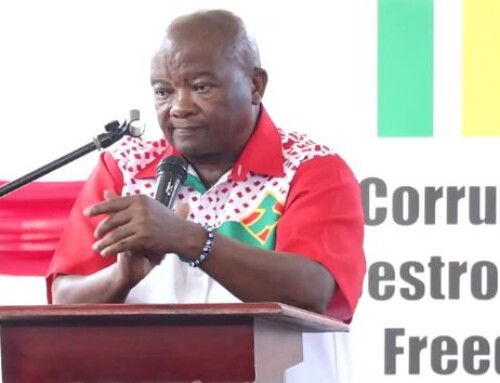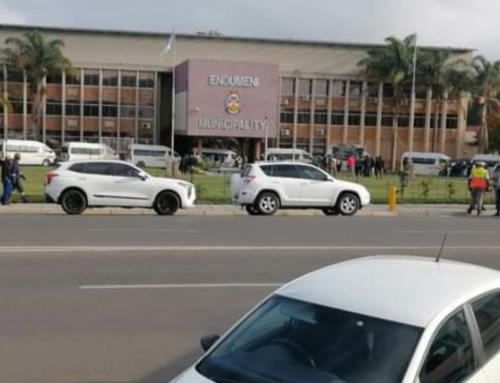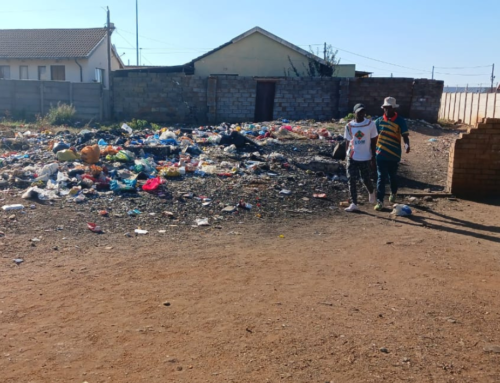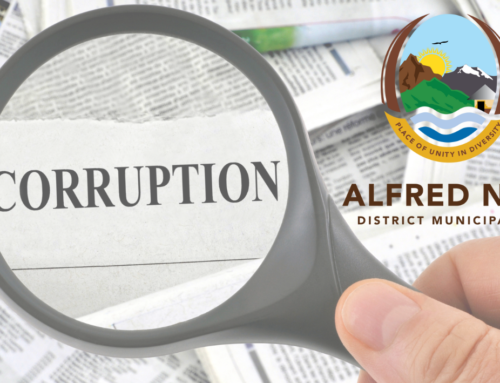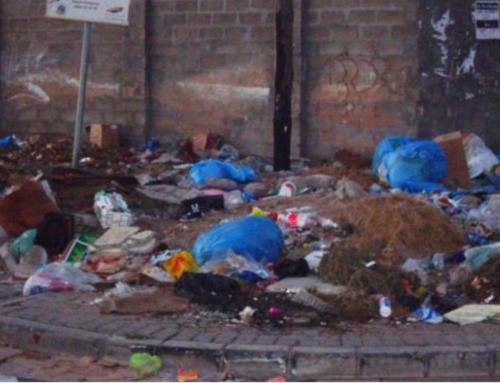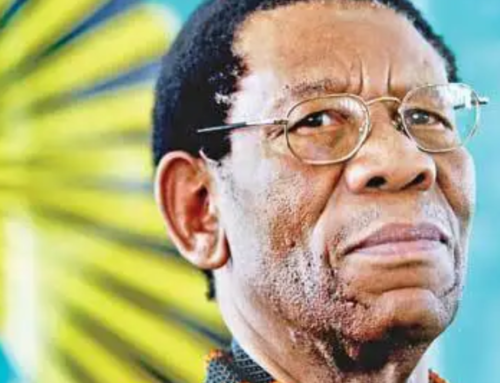

Chairperson of the Judicial Commission of Inquiry into State Capture
PO Box 31322
Braamfontein
2017
Per the acting Secretary of the Judicial Commission of Inquiry into State Capture
Dear Sir
SUBMISSION TO THE COMMISSION: THE REAL MASTERMIND BEHIND STATE CAPTURE
1. Corruption: a cancerous tumour
1.1. One of government’s major mistakes is delaying the implementation process to deal with corruption and addressing maladministration. It is evident that incompetence and corruption has collapsed and downgraded this country, thereby costing our economy billions of Rands. As a result of this undesirable culture, many municipalities have crumbled, because there are no effective structures to stop corruption, and to prevent maladministration and mismanagement of funds.
1.2. We acknowledge that measures have been taken, such as the formation of the Judicial Commission of Inquiry into State Capture (‘the Commission’) so that it may establish who has captured the state, but the process has been laborious and, in our view, not nearly far-reaching enough.
1.3. The former Public Protector, Professor Thuli Madonsela, had revealed that the Gupta family had effectively captured the state, however, as it turns out, the real architect of corruption is the ruling party itself, the African National Congress (ANC).
1.4. Accordingly, the Commission has been making the ruling party’s head honchos account for their alleged acts of corruption, but there is much more to this iceberg than what is presented to the public. Although the media and opposition parties, like the United Democratic Movement, have exposed some of the ANC and their leaders’ misdeeds, I believe most of it is kept diligently under wraps, because it might be the lurking iceberg that finally sinks the ANC Titanic.
1.5. The ANC and its leaders have misused state funds through companies like Bosasa, Chancellor House, Mohlaleng Media and Maverick State, to mention but a few. Looting from public resources has become a habitual act to fund the ANC by whatever means necessary, whether it be by paying its cadres’ exorbitant salaries or financing their election campaigns by any means necessary.
1.6. It is repulsive that this brazen looting takes place right under the noses of the authorities, whilst parliament’s oversight has not been effective either. The powers of the accounting officers have been usurped by the executive, consequently it has also affected the performance of state-owned enterprises.
1.7. The Commission’s terms of reference states that your work shall be guided by the Public Protector’s state capture report and we have noticed from the testimony that other accounts of corruption have been creeping out of the woodwork. It is therefore evident that there is a ‘big picture’ corruption that must be looked at.
1.8. Whilst much is made of Guptagate implicating former President Zuma and some other insatiable cadres, the fact that the corruption and looting at all spheres of government is to the benefit of the ANC itself, is negated. The Commission should therefore investigate the involvement of the ANC in acts of corruption, in totality.
1.9. This institutionalised corruption is not new, and it can be traced back through the previous decades. Even the Commission of inquiry into allegations of impropriety regarding Public Investment Corporation (‘PIC Commission’) quoted my testimony where I said that: “One of the most difficult tasks regarding dealing with the type of corruption that is alleged to have happened at the PIC is the sophisticated nature of the transactions. Corruption can come in two forms, legal and illegal corruption. Legal corruption occurs when the elite build a legal framework that protects corruption or manipulate existing legal framework without necessarily breaking the law.”
1.10. The PIC Commission concurred with my statement when they said in their report to the President that: “When going through the story of Harith, these words resonate. The layering of legal entities (state owned corporations, pension funds, banks, companies and trusts and partnerships etc.), when applied by financiers and corporate structure experts, can make finding the substance, and not form, of a transaction or series of transactions complex and quite perplexing. These layers also give the players in such a formation use ‘plausible deniability’ most effectively, as looking through all the conducts is challenging and time consuming.”
1.11. This designed incompetence permeates our law enforcement agencies, such as the police, the Directorate for Priority Crime Investigation (Hawks), the Special Investigating Unit (SIU) and the National Prosecuting Authority (NPA), which all have dismally failed to investigate and prosecute the reported culprits. One must be honest in one’s assessment of the competence of the state’s investigative and judicial resources. It is a given that the state lacks such competence in all respects, whilst the same is further exacerbated by means of prevalent corruption within the ranks of these institutions themselves.
1.12. The gate keepers of maladministration are the incompetent key administrative personnel who have been deliberately appointed (deployed) to accomplish the agenda of looting state resources on behalf of the ANC and, of course, to feed their own personal greed. It must be borne in mind that the ANC’s cadre deployment policy is just another form of corruption. It is called nepotism for a reason, because making appointments based on party affiliation, friendship and familial connections violate the statute books and is patently wrong. Cadre deployment deprives our civil service of talented individuals and we have thousands of young South Africans with degrees who cannot find jobs.
1.13. Epidemic levels of corruption handicaps service delivery which results in many violent protests. Not only that, prospective international investors shun South Africa because of the high levels of corruption and sadly our people are paying the price. Ultimately, corruption is destroying the gains of our freedom and patriotic South Africans have lost all hope and endlessly question the so-called measures put in place to address this untenable situation, whilst the ruling party itself perpetuates corruption in order to sustain itself.
1.14. Let us remind ourselves of what the late, former President Nelson Mandela admitted, already in 1998, about corruption in South Africa: “Unfortunately there are officials who betray their calling… this is part of the wider cancer of corruption that is undermining our efforts in all areas of society. We have learnt now that even those people with whom we fought the struggle against apartheid’s corruption can themselves become corrupted.”
1.15. The sad state of affairs is that the liberators of yesteryear have become the perpetuators of this immoral pillaging of state resources, whilst we are misdirected in our focus on the Gupta’s involvement in state capture.
1.16. The true architects of state capture are those who run government and its institutions in collusion with certain elements within the private sector. The private sector, which particularly benefits from government tenders, is represented by individuals who are shareholders in large corporations. These individuals appear to represent the private sector, but instead they use corporate fronts that merely return the loot to the ANC. These individuals also represent the corrupt interests of the ruling party in that they are either ANC stalwarts or that they are connected in one or other compromising manner to that party, politically or otherwise.
2. A Nelson Mandela Bay example: Mohlaleng Media, the ANC’s access to public funds
2.1. The purpose of this letter is to request the Commission to investigate the mechanisms used in government institutions to misuse state funds, especially at local government level.
2.2. I was recently briefed, on the matters which I raise below, by Mr Werner Wiehart, a persecuted forensic investigator formerly employed by the Nelson Mandela Bay (NMB) Metropolitan Municipality. He indicated to me that he had forwarded the information to numerous political parties and as well as the Commission (See Annexure A), but I took the liberty to meet with him last week and wish to report the matter to you formally.
2.3. The matter centres on how municipal funds have been looted by the ANC over, at least, the past fifteen years in NMB. Some information is already in the public domain including those that have been reported to the police, Hawks, NPA and the Public Protector.
2.4. The documentary evidence, which I have in my possession, convinced me that there is prima facie evidence that NMB municipal funds were looted for the ANC’s benefit, to fund its operations and to sustain itself. Questionable entities or companies (which are non-compliant with tax obligations and also lack related tax and billing clearances) and the registration of multiple enterprises simultaneously, are used as tools to achieve their dastardly goals.
2.5. Furthermore, I noted that law enforcement agencies remain actionless where corruption in the NMB municipality, more often than not, remains uninvestigated – in some cases, for more than three years. I cannot over-emphasise my concern if this is the alacrity with which this government is driving the fight against corruption, whilst little or nothing is achieved to start off with.
2.6. The widely publicised NMB Integrated Public Transport System (IPTS) scandal, in which National Treasury is implicated, is simply not being addressed, except for a single case in court. National Treasury, with particular reference the Chief Director, Mr Jan Hatting, had apparently been informed in writing during October 2012 of the large-scale looting, yet with such knowledge National Treasury continued to make payments thus feeding the large-scale looting scheme over a period of a further three years. So, nothing is happening, whilst the thieves are still trawling through personal protective equipment (PPE) tenders to rake in money to fund the ANC’s campaign for the 2021 municipal elections.
2.7. The evidence in my possession shows that, according to Mr Wiehart, there were three key players from Luthuli House involved, namely, Mr Pravin Gordhan (then Minister of Cooperative Governance and Traditional Affairs), Dr Crispian Olver (famous author of “How to Steal a City: The Battle for Nelson Mandela Bay: An Inside Account) and Mr Cheslyn Mostert (a well-known ANC operator), who presented themselves as those mandated to address the NMB municipality’s issues; a process which led to the appointment of Mr Danny Jordaan as executive mayor and Mr Johann Mettler as acting city manager.
2.8. The same process led to the suspension (with full pay) of some municipal officials and their subsequent resignations, as well as some limited dismissals. Amongst others, these suspensions and resignations were caused by the allegations that some of the employees benefited from the IPTS deal.
2.9. Prior to the aforementioned ‘Luthuli House intervention”, the opposition, the media and the people were voicing out their anger about the IPTS corruption and as a result our Mr Mongameli Bobani, an ordinary councillor at that point in time, asked the Public Protector in October 2014 to investigate the matter. The Public Protector’s Advocate Tom had apparently investigated, but the final report was never made public. The municipality had appointed legal firms which have cost the rate payer more than R100 million over three years.
2.10. The evidence shows that the hand of Dr Olver extends beyond ‘helping the municipality’, but that he also played a role in the mismanagement of funds which were channelled to the ANC through a company called Mohlaleng Media, which served exclusively as the propaganda machinery of the ruling party in NMB.
2.11. On 1 March 2016, Dr Olver provided Mr Mettler with the following documentation:

In this email Dr Olver informs the acting city manager that: “Here are the two CVs from Cheslyn, together with the draft letter to be signed and sent back to him, and the rates for the resources has set out in the SLA. The start date in the letter needs to be changed to Monday Next Week.”
2.12. A “tender” for R7,5 million was awarded to Mohlaleng Media, however the municipality failed to comply with its obligations in terms of the Municipal Finance Management Act to conclude the prescribed SLA which had to be signed between the municipality and Mohlaleng Media prior to commencement of any services. In fact, on assessment of the information, it is evident that Mohlaleng Media’s bid is riddled with fraudulent information, whilst even the entire procurement process was rigged from inception in favour of Mohlaleng Media.
2.13. Mohlaleng Media operated from December 2014 to February 2016 before any so-called SLA was signed on a fraudulent basis and of course the ratepayer footed the bill. This so-called SLA is referred to as an addendum to a former SLA, which never existed, hence, fraud. The tender/contract period entailed three years, however the bid value of R7,5 million had already been exhausted within the first ten months of the contract period.
2.14. Documentary evidence reveals that Mohlaleng Media invoices merely claimed monthly “resource cost” which eventually reached the amount of more than R21 million versus the actual approved bid value of R7,5 million over three years. These invoices were specifically created in such a manner to conceal the true nature of the work/service performed by this ANC aligned communications machine.
3. Mohlaleng Media forensic investigations, the cover-up and harassment of an investigator
3.1. One of the things I noticed as I went through these files is the harassment of Mr Wiehart by the office of the then Democratic Alliance executive mayor, Mr Athol Trollip, and his chief of staff together with the then acting city manager, Mr Johann Mettler. The harassment resulted in the malicious suspension of one of the municipal auditors based on fabricated and trumped-up charges and who was eventually expelled in a collusive manner.




3.3. An internal investigation had been done regarding Mohlaleng Media during which the Chief Audit Executive and forensic investigator, Mr Wiehart, questioned Mr Mettler’s involvement, which clearly caused discomfort in some quarters given the backlash that followed.
3.4. After Mr Trollip became aware that Mr Mettler and Dr Olver were implicated in the internal investigation on Mohlaleng Media, he had the terms of reference that was prepared by the internal audit team changed and, in essence, had it watered down in order to intentionally and actively conceal ANC corruption using an external forensic inquiry. In fact, Mr Mettler drafted the terms of reference for the external audit, which was a clear conflict of interest. The new terms of reference did not require the investigation of Mr Mettler and Dr Olver’s involvement, which was obviously intentional and self-serving.
3.5. A certain Morrison and Vermeulen were appointed on 31 May 2017, with the new terms of reference, whilst Mr Wiehart was placed on compulsory special leave, during which he was persecuted on the basis of fabricated charges of misconduct. Morrison and Vermeulen apparently performed very poorly, and in fact showed little progress. Mr Morrison furnished a preliminary report on 6 November 2017.
3.6. Mr Morrison’s final report does not contain the factual findings that were communicated to him since May 2017, nor did he make any reference to evidence furnished to him by a whistle-blower whose disclosures are included in the documents that I have now studied.
3.7. Same resulted in the comprehensive Chief Audit Executive review queries in that Mr Morrison had simply not performed, but more concerning is the fact that he collusively acted with Mr Mettler in concealment of impropriety by Mr Mettler, Dr Olver and others.
3.8. From the evidence before me, Mr Morrison is in all probability a compromised individual who did not render the service that he was appointed and paid for. This is how entrenched corruption is in our society, that even external forensic consultants are prepared to engage in the very same cancerous agenda that society is attempting to eradicate.
3.9. According to Mr Wiehart, Mr Trollip had even gone so far as to hide documents at his residence for a period of twenty-six months after a forensic report was furnished to a Hawks investigator in March 2018. Mr Trollip may say that he was the one who mandated the investigation, yet he must be made to account for his collusive actions in protection of corrupt officials and politicians.
3.10. This entire narrative raises a concern, which is that “the system” used in NMB to loot funds through companies like Mohlaleng Media could be, and probably is, “the system” that is replicated in other municipalities (and even other spheres of government) in favour of the corrupt and looting ruling party.
4. The leaked CR17 campaign bank statements: the same names crop up
4.1. Mr Wiehart further took me into confidence and shared information with me that relates to Linkd Environmental Services of which Dr Olver is, at the moment, the sole director. This three-man operation in 2017 entered into an SLA with Ria Tenda Trust (which belongs to President Ramaphosa) to provide accounting and financial services (https://www.thepresidency.gov.za/download/file/fid/1649) This is rather odd, because Linkd Environmental Services is not a financial services or accounting firm at all. What had apparently piqued Mr Wiehart interest had been that, given what had transpired in NMB, that this might be a case of history repeating itself.
4.2. I was shown some of the various leaked bank statements, that are quite easily accessible on social media platforms and, even though they have been sealed by the court , they therefore can never enjoy protection from public scrutiny.
4.3. What can be seen from these bank statements is that a bank account was utilised to channel alleged CR17 campaign funding. I find it questionable that the principals segregated so-called day to day business operations, with alleged campaign donations, as one would expect that separate trust accounts be opened and be managed in a transparent manner.
4.4. What was however of much interest to me, given the context of this submission, was that these statements showed the involvement of the very same individuals involved in the NMB/Mohlaleng Media corruption. They are Maverick State (formerly known as Mohlaleng Media), Crispian Olver, Cheslyn Mostert, Grant Pascoe, Vukile Pokwana and some others.
4.5. I was also shocked by some of the names of the listed beneficiaries, where I saw that many members of the ANC received money, totalling millions of Rands, in their personal bank accounts. Although, I hold no brief for the ANC as an organisation, I am concerned about Crispian Olver and Cheslyn Mostert’s seeming endgame. Whilst on the one hand, their hands may loom large in the corruption that has been taking place in NMB and on the other hand, Dr Olver’s company is alleged to have distributed millions of Rands to ANC members. There seems to be a strange disconnect between those actions.
4.6. That said, my concern is that, from where exactly did the funding in Dr Olver’s company bank account originate. On review of the deposits, it is evident that these origins are not vested in well-known and/or credible corporate resources from the private sector. Considering how Mohlaleng Media was used to fund and sustain the ruling party’s ever-hungry hyenas in NMB, one cannot believe that there is any legitimacy behind the so-called donor funding from private individuals or corporations.
4.7. Who are the real ‘donors’ and from where does such funding truly originate? Looking closely at the methodology used by Bosasa, and what could possibly be used by Linkd Environmental Services, one is left with unanswered questions as to who the real architects of state capture are. This is the actual question that must be considered, and investigated, by the Commission.
4.8. The innocuous words ‘donor funds’ are constantly used, whilst the biggest and most important ‘donor’ is the state through the looting of public funds. These so-called donor funds emanate directly from state contracts and government tenders and not from happy and morally complacent ANC supporters.
5. Conclusion
5.1. To verify the authenticity of the information contained in this submission, the Commission should consider conducting a preliminary investigation by engaging Mr Werner Wiehart. All the documentation I have scrutinised is available on request.
5.2. Furthermore, to aid its work, the Commission would be well advised to request the Public Protector’s report on its 2014/15 investigation of the NMB municipality’s IPTS system, as well as all the NMB corruption cases that have been reported to the police, Hawks, SIU and the NPA.
6. Parting shot: the money must be recovered from the ANC
6.1. We, at the moment, spend a lot of time talking about corruption and plumbing its depths, which is of course right. But we must also emphasise the imperative that all the moneys that have been pilfered through tender rigging, as was done with the eye-opening Bosasa shenanigans, in favour of ANC linked companies, or ANC leaders and linked individuals or the party itself, must be recuperated.
6.2. Tracing exactly into whose pocket the money went might look like an insurmountable task, and it probably will be a massive operation. But not tackling this task, would be short-changing South Africans from the moneys that should have been spent to make manifest their constitutional rights. Simple as that.
8. I remain at your disposal.
Yours sincerely
Mr Bantu Holomisa, MP
President of the United Democratic Movement
Copied to:
• President of the Republic, Mr Cyril Ramaphosa
• Minister of Finance, Mr Tito Mboweni
• Speaker of the National Assembly, Ms Thandi Modise, for the relevant portfolio committees’ attention
• NMB acting Executive Mayor, Cllr Thsonono Buyeye
• NMB acting City Manager, Mr Mandla George


